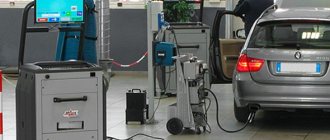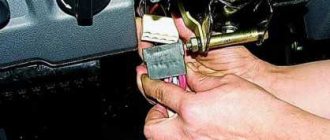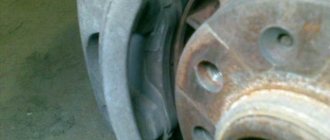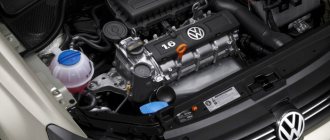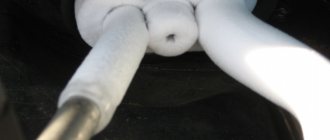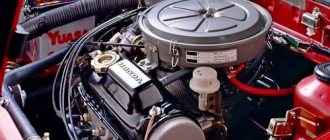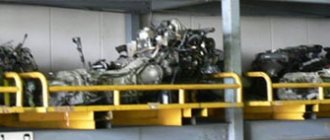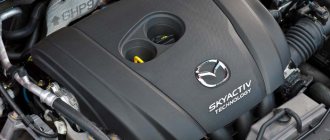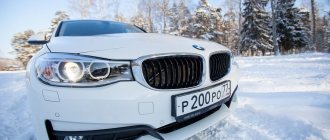25.03.2017
Do the caliper guides need to be lubricated at all? It is necessary, and with special lubricants specifically designed for such parts. What is suitable for other components and assemblies of your car may not be suitable for others. This is especially true for devices on brakes. The guides, as a part of the brake system subject to intense influences, require special care.
What can't you lubricate?
Is it possible to lubricate caliper guides with substances that have proven themselves to be effective for other parts? For example, copper grease or lithol? If you act on the principle “everything is better than nothing at all,” such lubricants may be suitable. However, it will not be possible to truly protect the surfaces of the guides in this way. The fact is that the calipers of modern disc brakes are designed for extra-heavy, extremely intense work.
The temperature during friction between the disc and the pad reaches 500-600 degrees Celsius. When removing and dissipating thermal energy, other parts of the calipers heat up to 150 degrees or more. We are talking not only about aggressive driving on sports tracks, but also about driving on fairly rough terrain. Also, in any environment, the caliper is affected by water and salts that cover the road surface. Not to mention the impact that far from neutral brake fluid has.
Obviously, such loads require special lubricants designed to operate brake caliper guides under extreme conditions. The properties of all other lubricants are contraindicated here: coking, being washed out by water and dissolving in the brake fluid. With prolonged use, conventional lubricants are deposited on the plastic and elastomer parts of the calipers. This has a detrimental effect on them and causes brake failure when driving, which jeopardizes the safety of the driver and those around him.
Rating of the best lubricants for calipers and guides
Let's take a quick look at several popular brake caliper and guide lubricants.
- TRW PFG110. Perhaps the most popular lubricant for the brake system in the Russian Federation. Suitable for both caliper pistons and guides. Compatible with brake systems designed to work with glycol fluids (DOT-3, DOT-4 and DOT-5.1). Sold in 25 gram tubes.
- PAG from the company VMPAvto. Multi-purpose lubricant suitable for use under caliper pistons and guides. Positioned as a domestic analogue of TRW PFG110. Created on the basis of calcium and lithium soaps. Compatible with glycol brake fluids. The lubricant is available in 5 gram tubes.
- Liqui Moly Anti-Quietsch-Paste. Universal paste for application to caliper guides and pistons. Available in 10 gram bags. It is somewhat more expensive than lubricants for the same purpose, but, according to reviews from car owners, it resists washout better and does not degrade longer.
- Febi Special Lithium Grease. Lithium grease, which is formulated for guides, can be used to lubricate calipers without disassembling, but is not recommended for lubricating the internal cavity of the caliper cylinder when removing the piston. It is usually used in car repair shops, as it is sold in a large volume for ordinary motorists: 180 grams.
Also, most manufacturers of spare parts for the brake system include specialized lubricants in the delivery kit. For example, caliper repair kits usually come with lubricant. Sometimes the lubricants are divided: some are intended for the caliper, others for the guides.
Copper greases and spray lubricants for calipers and guides are considered unsuitable and are not generally used for these purposes.
You can buy lubricants for calipers and guides at the best price in our online store.
What should I lubricate with?
What kind of lubricant should I use to lubricate the brake caliper guides to protect them with maximum reliability? Even if you do not know the names of modern lubricants, you can navigate their technical characteristics. By understanding the requirements for guide lubricants, you will be able to say for sure what is right for you. Much also depends on the materials from which the caliper parts are made, since not every lubricant is compatible with them.
The main requirements for lubrication are as follows:
- the lubricant must have a high operating temperature (more than 180 degrees Celsius);
- at least, the operating temperature should not cause the lubricant to drip, that is, it is unacceptable for the lubricant to melt and leak out during operation of the guides;
- the lubricant must be waterproof and chemically stable, that is, water or brake fluid must not be its solvent;
- The lubricant is required to be compatible with every plastic or elastomeric part included in the caliper system, including the rubber that is often used there.
An equally important characteristic of the lubricant is the manufacturing company. High-quality brake caliper guide lubricants are rarely made by companies that make lubricants for everything else. The exception is brake system manufacturers, since many of them specialize in everything related to these systems. A good example of this is Toyota, Slipkote, etc., which are some of the most well-established brands today.
How to get rid of squeaking pads in five minutes with your own hands
The squeaking of brake pads causes maximum inconvenience, not only annoying while driving, but also raising concerns about serious damage. In fact, there are several tips on how to get rid of unpleasant sounds in five minutes with your own hands, which are worth talking about in more detail.
Common causes of squeaking. The main cause of squeaking is wear of components, which requires replacement of parts. However, there are several other reasons why unpleasant sounds begin to be heard during braking. Among the most common:
- Pad vibration
- Worn brake disc
- Appearance of a groove on the disc
- Ingress of sand, moisture, dust
If a breakdown is detected, you need to look at how to fix it. For example, if moisture or sand gets in, it will be enough to clean the surface with a rag. While driving, dirt and abrasive materials fall on the uneven friction layer and are then spread across the disc. But when a groove appears, you will have to sharpen the brake pads.
Determining the sound source. Before starting repairs, you should carefully inspect the car and determine on which side the squeak appears. The wheel is then carefully removed, after which the disc is inspected for any damage. The most common source of squeaking is usually the front wheel on the right or left side, and therefore it is removed and checked to see if the friction layer is even.
If it is uneven on one of the pads, you can smooth the surface with sandpaper. Some motorists advise simply lubricating this place, which will be enough.
Vibration of pads in caliper. Vibration of the pad in the caliper can also cause unpleasant sounds, and a special lubricant will help cope with the problem. It is applied to the metal side of the part. After application, the material is left until it hardens, then the brake system is reassembled. The vibration will disappear, and with it the unpleasant creaking.
Other methods for getting rid of squeaks. There are several other methods to help get rid of squeaking brake pads. One of them is rounding the corner parts of the block or creating cuts. Vibration may occur due to the fact that during braking the greatest pressure is placed on the edges of the pads. The rounding procedure will help soften the braking process, and the cut will become a collection point for dust and moisture, friction material that wears off when driving, thereby saving the car owner from squeaking.
Bottom line. The squeaking of brake pads causes inconvenience to motorists, irritating them when driving. Unpleasant sounds can appear for several reasons, but if they are not too serious, they are easy to get rid of. This will only take five minutes and no extra costs.
The main thing is to remember that the car will serve the owner for a long time and properly only when he pays due attention to the inspection and repair of the vehicle. You should not ignore even minor breakdowns or the appearance of strange and unpleasant sounds.
- Rain is a joy for us. Test drive of Viatti Bosco H/T V-238 SUV tires
See all photo news >>
Recommended lubricants.
What is the best way to lubricate caliper guides? If we talk about professional lubricants produced by automobile concerns, they are quite expensive - usually about $20. On the other hand, they are always enough for a long time. If, for example, you are the owner of a Toyota, then it is recommended to choose Toyota White Grease, etc. Based on the names of the concerns, the easiest way is to choose the most suitable lubricant specifically for your car. By doing this, you probably won't go wrong.
Multi-purpose lubricants are often used by owners of sports cars and other machines intended for use in extreme conditions. They will not harm any other car that undergoes regular strength tests on Russian roads. We are talking primarily about Slipkote® 220-R DBC.
Its paste for caliper guides, Molykote Cu-7439 Plus, has a number of properties that make it especially attractive in our conditions. The most important of these is frost resistance, which allows the lubricant to operate even at -30 degrees.
The cheaper (only 3 dollars), popular lubricant for guides, Very Lube, is no less resistant to cold. In general, this lubricant is advantageously characterized by the widest operating temperature range. Its lower limit is -35 degrees, the upper limit is around 400. It is also characterized by poor washability, high tenacity on metal and relative neutrality to plastics.
For domestic cars, the well-known CV joint is recommended, which, unlike many other lubricants, is practically universal, including suitable for guides. Its main advantage is that it is absolutely indifferent to rubber and plastic. This distinguishes it favorably from many foreign lubricants, which still exhibit some aggressiveness when in constant contact with non-metallic parts of the caliper.
Types of lubricants suitable for the brake system
Not all lubricants are identical in composition and characteristics. There is even a small classification that allows you to divide all types of products into three large groups, taking into account their properties and capabilities. Many well-known and reliable companies produce lubricants of this type, but it is extremely difficult to choose a universal product, so you should focus on the requirements of a specific car and the capabilities of a specific substance. Let's look at them in more detail in the table.
Read also: Carista obd2 pro torrent
| Options | Synthetics or mineral water with added metals | Mineral oil based lubricants | Synthetic oil based paste |
| general description | High-temperature lubricants with good extreme pressure properties. Particles of molybdenum or copper are added to the compositions. | Lubricants that include mineral oil and bentonite as a thickener. They do not have a dropping point. | The substances are compatible with polymers and rubber. They are made on a synthetic basis with the addition of additives and a thickener. They do not dissolve in water. |
| Features of application | You can lubricate the surface of the cylinder, springs and pad plates. | The lubricant is suitable for applying to the “fingers” of calipers. | Suitable for all disc brake caliper parts. |
| Most Popular Brands | Brands can be distinguished: |
- Huskey;
- Loctite;
- LIQUI MOLY;
- Mannol Kupfer;
- Valvoline Cooper.
- ATE Plastilube;
- Loctite Plastilube;
- Molykote.
In Russia, domestic paste MS-1600 is offered.
Based on the proposed description, we can say that the optimal choice is to purchase lubricants from the third group, since they have excellent technical performance. Additional information about lubricants in this category can be found in the video:
How to lubricate - instructions.
How to lubricate the caliper guides to completely protect them from any destructive influences? The rules here are simple, and for all types of lubricants and car brands they are approximately the same. By following simple step-by-step instructions, you can quickly learn how to lubricate brake caliper parts yourself, without wondering how to do it correctly.
Unscrew the mounting bolts and remove the caliper body.
- We remove the guides along with the anthers.
- We clean the bushings from old grease.
- Lubricate the guides and insert them into place.
- Reassemble in reverse order.
In order for the caliper to close back, it is necessary to retract the cylinder using special pliers. If they are not available, improvised objects will do: a wooden block, the shaft of an ax or hammer, etc.
Video instruction.
Reviews from car owners.
Alexander:
“Of all the commercially available lubricants, I prefer Very Lube. It is universal and relatively cheap. And at the same time, it not only has the characteristics of professional lubricants, but also surpasses them in many ways. In Irkutsk. Where I live, temperatures below 40 degrees are not uncommon. But Very Lube works excellently in such conditions.”
Ignat:
“For my “focus” I prefer Slipkote, although I have tried many universal imported lubricants for guides. It’s not cheap, but good brake system protection justifies the expense.”
Victor:
“I own a small fleet of domestically produced trucks. And I prefer CV joints as a lubricant for caliper guides. It reliably protects this part without any “side effects”.

